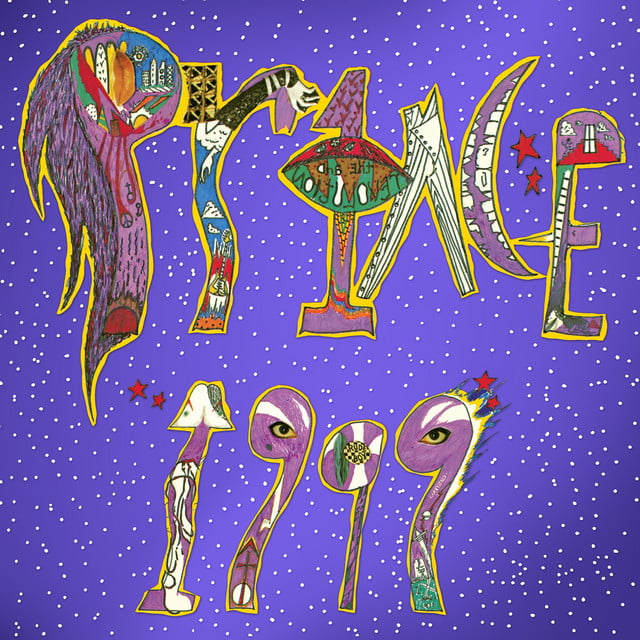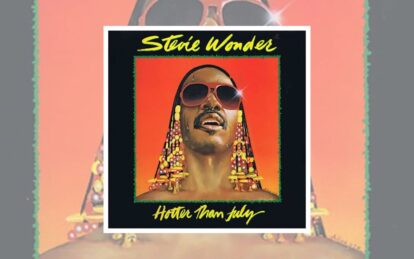
Prince: 1999 cover
Prince: 1999 was a landmark album for the Purple One and his first truly classic release… By Felix Rowe
As far as we’re aware, Prince is the only pop star to have been honoured with his very own Pantone colour. ‘Love Symbol #2’ is its name and no prizes for guessing it’s a rather delicious shade of purple. But it’s not just a colour that Prince has claimed as his own.
He has come to define his own unique sound, to the point where the very word ‘Prince’ has itself become a musical shorthand for adding a little more spice into a performance: “Can you please make it sound a bit more Prince?” In other words, more funky, more visceral, more sexy… you know, more Prince.
A prodigious talent, Prince had long been shocking audiences, not only with an incredible musicianship, but also with song titles alone to make you blush. A gifted multi-instrumentalist and prolific songwriter, he had refined his sound and look across four studio albums in just four years between 1978 and 1981.
An incredible feat for any group, but even more so for a solo artist who did it all largely single-handedly, writing, performing and producing almost everything.
By the turn of the 1980s, Prince had gained a degree of notoriety on the R&B circuit, was playing sizeable venues to a select audience, and had gained himself some influential fans (Mick Jagger among them), but crossover success still eluded him. Album number five would correct that. If you had never heard of Prince before 1999, that all changed swiftly.
On 1999, Prince reached an artistic and commercial apex, finally becoming a mainstream artist five albums into his career. It was the moment that he had been building up to; the culmination of the work he’d put in to get to that point, refining the vision and building upon what had come before.
As well as his penchant for the colour purple and being friskier than a Duracell bunny on heat, Prince was particularly well known for his singular vision. His desire for total creative control is legendary.
He played every single note of every instrument on his first album, For You, and that solitary approach essentially set the template for his first few records. Gradually, however, he began to open up the door to let a select few individuals into his private world.
By 1999, a distinct change in approach was emerging. Perhaps by now he had proved the point, gained the self-assurance, or simply found the right people. Whatever the logic, he became increasingly more collaborative (or, at least, willing to delegate specific tasks to others under his meticulous direction).
While Prince still played the vast majority of the instruments on 1999, there were exceptions. Notably, he relinquished the Little Red Corvette guitar solo to his axeman, Dez Dickerson, (whereas on earlier albums, he surely would have opted to play it himself). Crucially, 1999 marked the introduction of his band, The Revolution.
It wasn’t a sudden outpouring of modesty, but all part of his masterplan. Dickerson has described Prince as both ‘spontaneous’ and ‘calculating’, “in a good way”, always with an eye on the commercial implications.
Giving his band a name on the bill – rather than being an anonymous bunch of session musicians – cemented their status as a unit, making the enterprise feel bigger and more substantial.
Prince’s willingness to share the stage is pointedly demonstrated in his decision to give the opening lines of the song 1999 (and hence the album) to his band mates. Far from diminishing his role, this move served only to strengthen it.
It’s the classic theatrical move of building the suspense and saving the best until last. In holding back his own dramatic entrance, it made it all the more potent when the moment arrived.
But this development extended beyond just his immediate band. Prince was building a family – perhaps even an army – with himself as the patriarch. Better to be the leader of a gang than go it alone, a mere sole trader. What’s more, the notoriously prolific songwriter was in such top form that he was churning out more songs than he could deal with.
His vision was too large for just one individual to carry. Why bother fighting to join a scene when you can simply make your own?
So that’s exactly what Prince did, creating other vehicles for expression, nurturing projects including groups The Time and Vanity 6. He even adopted the producer alter ego, Jamie Starr, a moniker that allowed him to explore another side of his character that he couldn’t under his own name.
Read more: Top 10 Prince songs
Read more: Making Prince’s Sign O’ The Times
These activities weren’t ancillary; they were all part of his bigger vision. But, of course, he planted himself as the centrepiece, and the Minneapolis movement’s totem statement was his landmark album, 1999.
Prior to recording 1999, Prince got burnt opening for The Rolling Stones – his outrageous attire and sexually provocative demeanor proved too much even for this audience and they were heckled and booed off stage amidst a barrage of missiles.
Prince’s response was to decamp to the studio, immerse himself in music and, according to Minneapolis music journalist Andrea Swensson, become “a superstar on his own terms.” Rather than going to the audience, make the audience come to you.
With 1999, Prince pioneered his own signature sound with its own definable characteristics, a sexy, synth-laden funk-pop, with elements of rock and R&B combined to create something totally fresh.
The futuristic sound was enhanced with synth stabs typically replacing a live horn section, and heavy use of the recently released Linn LM-1 Drum Computer, which Prince would feed through his guitar pedals to create even more otherworldly sounds.
This technology allowed the family unit to become more self-sufficient than ever. With a whole range of new sounds to tap into at their fingertips, the possibilities were endless. This distinct style became to be known as the Minneapolis sound. First expounded by Prince and his wider family, it was replicated by others outside the fold around the world.
Indeed, a certain would-be King of Pop took direct influence from the punchy synths of 1999 on his own burgeoning masterpiece.
It’s interesting to observe that while both Prince and Michael Jackson set out – dripping in confidence – to make defining records that would cement their superstar status, there is one very notable difference in their approaches. Unlike Thriller, which is consciously streamlined and trimmed down to its core essence, 1999 is the polar opposite of lean.
Where MJ gets straight down to the point, Prince allows each track the space to gestate, bubbling up slowly, like a physical workout routine that builds and builds before eventual climax.
Had Quincy Jones produced 1999, he would undoubtedly have shaved a sizeable chunk off the running time – after all, he thought the intro on Billie Jean was too much. But in Prince’s hands, 1999 is essentially one long victory lap. It feels as if he’s performing extended versions of well-established hits live, rather than introducing them for the first time on record. Four tracks extend over seven minutes, with Automatic rolling on for nearly ten.
It’s certainly an indulgence, and though it might be deeply sacrilegious to say so, the album could easily have been distilled down to under an hour.
Still, you just have to admire Prince’s unshaking bravado and refusal to truncate his vision. Prince was thinking visually, cinematically, even. An avid fan of movie nights with his inner circle, he took much inspiration from the big screen.
Quadrophenia apparently inspired the trench coats and (in turn) his own music movie, Purple Rain. By 1999 Prince had shaped a futuristic look befitting the music – shimmering hair, boxy jackets and guitars as angular and razor-sharp as the tunes. The birth of MTV in 1981 proved the perfect outlet for Prince to present the entire package to whole new audiences.
At the turn of the 80s, American radio was still notably segregated. Yet 1999’s singles went on to enjoy heavy rotation on mainstream radio and MTV. As such, the album was notable for making Prince one of the first black artists to get such broad airplay on the wider pop channels, as opposed to the R&B charts alone.
Prince now appealed to the white record-buying public, and in doing so, opened the door for others in his wake.
1999 was the album that propelled Prince into the big league. It gained him his first Grammy nomination and first Top 10 album. But he achieved this without diluting his vision; he didn’t suddenly become more acceptable to conservative sensibilities. After all, there are some very naughty bits on 1999 – he was as controversial as he had ever been.
Yet he refined his pop hybrid sound and brought in rock elements that enabled him to open doors previously closed to him. 1999 also set up the juggernaut that followed, 1984’s Purple Rain. Prince was in his stride and had entered a genuine purple patch that’s still pretty mind-boggling 40 years on.
Read more: The Revolution interview
Prince: 1999 – The Songs
1999
Prince’s apocalyptic shagfest carries all his signature hallmarks, from slick synths to sensual vocals. According to Dickerson, the explosion sound effects were added to mask performance imperfections. While this may seem at odds with the notion of Prince the perfectionist, it ably highlights that his view of perfection was as much about capturing the spontaneous magic as it was achieving technical refinement.
Little Red Corvette
Less futuristic and forward thinking than 1999, this nevertheless demonstrated another side to Prince’s character. Little Red Corvette proved beyond doubt that Prince could master the rock ballad vibe as well as anyone out else there. With big echoey guitars and gospel vocals, it shows the scope of his ambitions to be considered a rock icon as much as a pop star.
Delirious
This upfront pop number rattles along on an infectious groove that recalls 50s rock ‘n’ roll, pushed through an 80s electro prism. Taking its cues from classic jukebox staples like Hound Dog and Rock Around The Clock, Prince flips the script with the Minneapolis sound, complete with drum machine, synth pads and that insanely catchy nagging synth hook.
Let’s Pretend We’re Married
The fourth single in a row kicks off with a persistent electro groove, almost proto-industrial in mood. This makes way for a chugging, jittery new wave vibe, pushed along on synth stabs. It’s one of the longer cuts at almost seven and a half minutes, and perhaps a couple of minutes could be shaved off to its improvement. It has a chaotic feel, with plenty of screaming and primal sounds, culminating in a seriously X-rated spoken word section in the final quarter.
D.M.S.R.
Kicking off on drum machine and a syncopated synth line, this is one ridiculously funky track, dripping with libido. A rubbery bassline (seemingly played by doubling up bass guitar with a synth) is punctuated by pitch-bending synths and slinky guitars. At over eight minutes long, it’s another extended marathon jam, as Prince chants the four things he really wants for Christmas in sensual repetition: Dance, Music, Sex, Romance. It’s pure Prince and it’s fantastic.
Automatic
Again the drum machine is put to good use, leading into a shrill synth part that makes way for a stuttering vocal. Dragging on for nine and a half self-indulgent minutes, Prince works through a range of interesting sounds, including slap bass stabs, screeching synths, vocal yelps, his trademark spoken-word sections and even some chipmunk (did MJ steal this for P.Y.T.?). A stonking lead guitar finally rocks in at seven minutes in a cacophony of orgasmic wailing.
Something In The Water (Does Not Compute)
One of the strangest yet most innovative tracks on the record, Prince combines dissonant and minimal electro flourishes with melodic vocals. Imagine Prince making love to a boxy 80s fax machine and you’re halfway there. It manages to get even more genuinely unsettling and futuristic as it goes on, while Prince descends into primal scream – a bold and compelling piece of art.
Free
Prince is back in rock ballad mode, which suits him rather well. Free opens with vast cinematic sounds of oceans roaring or wind howling and dramatic footsteps, before cutting back to a more intimate sound of a lone falsetto vocal coupled with piano. It gradually builds and evolves into a full band ballad. It’s much more traditional in its instrumentation and arrangement, but the change of pace is a welcome break after the extended, noodling synth jams.
Lady Cab Driver
One incredibly funky track with a blaxploitation vibe, complete with slap bass, slinky guitars and synth horn stabs. Over eight minutes, this is one of the few longer tracks to really warrant its extended length. Live drums propel it along, ramping up the tension effectively. Prince treats us to a delicious rap followed by more background screaming (definitely pleasure not pain). Then heavy guitar chords set the tone for some truly off-the-wall guitar soloing.
All the Critics Love U in New York
It’s hard not imagine this track as a Flight Of The Conchords parody. A drum machine grooves along to a funky jarring bassline, as Prince delivers a spoken- word monologue, playfully sneering at the vapid NY scene. It showcases some fabulously dissonant guitar soundscapes. The spacey sounds are excellent, though it could be distilled into a shorter, punchier cut. Having rolled on for almost six minutes, it then ends rather abruptly.
International Lover
A sensual 6/8 ballad, the live band arrangement allows more space to showcase Prince’s vocal talents. His falsetto reaches truly incredible heights before switching to a screaming rasp. His spoken-word sections are wonderful in their total ridiculousness: “Good evening, this is your pilot, Prince, speaking. You’re flying aboard the Seduction 747, hmm, and this plane is fully equipped with anything your body desires.” Now, you don’t get that treatment on Ryanair.
Read more: Top 40 synth-pop songs
Classic Pop may earn commission from the links on this page, but we only feature products we think you will enjoy.






